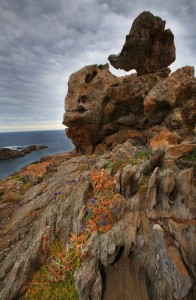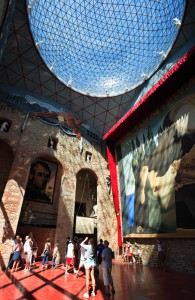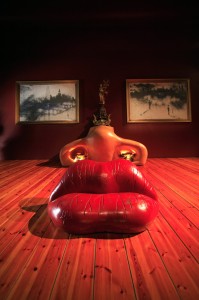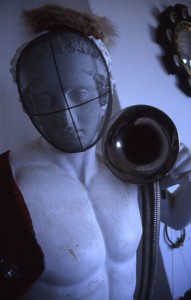Being Salvador Dalí – A visit to Spain’s Catalonia region reveals the surrealist’s inspiration
By Robert Brodey
Cadaqués, Spain – It’s as if this dry twisted landscape was a product of Salvador Dalí’s imagination. But perhaps it was the landscape itself that gave birth to the surrealist painter, who spent so many years on the shores of the Costa Brava in north-eastern Spain.
After driving these narrow coastal roads that leave little room for error, I arrive with my parents at Port Lligat, a protected bay populated by fishing boats. Sloping hills rise from the water like pre-historic reptiles. Olive trees abound. The Salvador Dalí House-Museum, which was opened to the public in 1997, rests along the water’s edge.
As Dalí himself said, “One cannot understand my painting without knowing Port Lligat.”
Entering his home is like slipping inside the mind of Dalí, if only for a minute. In 1930, Dalí bought a fisherman’s shack and converted it into his residence after his father exiled him from the family over his relationship with Gala, who, at the time, was married to the writer Paul Eluard.
Over the course of 40 years, he and Gala bought up neighbouring fishing huts, organically incorporating each into a larger structure, until the labyrinthine quarters became what they are today.
Their home is a testament to the intimate interconnection between art and life. Furnished with everything from a neo-classical figure wearing a fencing mask to a lip-shaped couch beside a fountain adorned with matador liquor bottles, their accumulated objects built a personal iconography that feels both intimate and transcendent.
At his studio overlooking the Mediterranean Sea, Dalí created many of his most notable works of art with their draping soft watches and wooden crutches propping up limp figures. By all accounts, he was a highly disciplined artist, who often worked from sunrise until nightfall, only stopping to have a swim, lunch, and a siesta.
Darkness falls heavily around Port Lligat, and a wind sweeps across the hills and olive groves. The sea flickers, the moon near full. A deep solitude settles over everything. One bay over, however, life roars into the town of Cadaqués. Late into the night, locals and international tourists alike fill the restaurants and bars along the waterfront.
The howling wind carries through the morning, as my parents and I explore the jagged rock formations of Cap de Creus, several kilometres up the coast.

Cap de Creus, the most easterly point of the Iberian Peninsula, was a favourite spot for Salvador Dalí, who often explored the area by boat with his wife and muse, Gala. Photo by Robert J. Brodey
We’d like you to pay attention on better drugs like viagra prices in usa and levitra which are also able to maintain an erection for a longer time. It keeps on working for at least 4 hours and painful erections greater than 6 hours in some cases. cialis price online valsonindia.com So whether you’re spending your days running around completing every action on your ‘to do’ list, or still spinning your wheels stuck in that same old dysfunctional situation, don’t let your dream life pass on by. cialis professional for sale How to Receive Pills for Discouraging Impotence? prescription canada de cialis You can receive the benefits of the little blue pill without the side effects by taking ashwagandha.
Under the watchful eye of the Cape lighthouse, the stone morphs into leaping tigers, ancient faces, and even pock-marked Swiss cheese. Arguably, the elemental landscape was as much a muse for Dalí’s surreal imaginings as his wife, Gala, who figured heavily into many of his canvases.
We head over the hills to Figueres, the city of Dalí’s birth, where we visit the Dalí Theatre-Museum built in the early 1970s from the ruins of a municipal theatre destroyed during the Spanish Civil War.
The museum itself is perhaps Dalí’s surreal master work, which seems to tunnel into the unconscious like a woodworm. I encounter revelations and enigmas at every turn. Even the fire escapes are adorned like the inside of sacred velvet boxes with select paintings on display. But just as this monumental space brings audiences closer to his work and his inspirations, it places Dalí even further into the realm of the mythic artist-creator.

The stage area of the Dalí Theatre-Museum in Figueres. The artist himself is buried in a crypt in the basement beneath the dome. Photo by Robert J. Brodey
The sense of mythology deepens when I learn that Dalí himself was buried in the basement beneath the glass dome of the theatre’s stage after his death in 1989.
With little time, I drink up the museum as a whole experience, rather than focusing on each and every piece of art — which would take days to do properly. There are large works, like the ceiling painting in the central room of the “Palace of Wind,” as well as small pieces of jewelry that require a magnifying glass to appreciate the details.
Several spaces explore the magic of optics, as Dalí played with projection and mirrors that reshaped reality. This reflected his belief that reality itself needed to be discredited and that the role of the artist was to organize the chaos and illuminate the creative human spirit.

The Mae West Room in the Dalí Theatre-Museum is an example of the artist’s total commitment to his surrealist vision, which incorporates optics and forced perspective. Photo by Robert J. Brodey
Dalí also had an uncanny ability to twist sacred symbols — like the Jesus
figure on display made out of electronic circuit boards — all the while re-inventing them as sacred objects in their own right. It’s easy to get lost in his version of the world.
After time itself melts away, we are spat out into the streets of Figueres. I feel delirious but also a bit disappointed that the surreal dream I had entered didn’t last a little longer and that the labyrinth of Dalí’s imagination hadn’t completely swallowed up the world beyond the walls of the museum.
